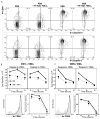Exposure to inorganic mercury in vivo attenuates extrinsic apoptotic signaling in Staphylococcal aureus enterotoxin B stimulated T-cells
- PMID: 17950395
- PMCID: PMC2195550
- DOI: 10.1016/j.taap.2007.06.002
Exposure to inorganic mercury in vivo attenuates extrinsic apoptotic signaling in Staphylococcal aureus enterotoxin B stimulated T-cells
Abstract
The heavy metal mercury (Hg) is known to have immunomodulatory properties affecting lymphocyte signal transduction, death receptor signaling and autoimmunity. In this study we tested the hypothesis that Hg exposure would attenuate T-cell activation and caspase 8 and 3 activity in response to antigenic stimuli. To test this hypothesis, BALB/cJ mice were exposed to 10 mg/l mercuric chloride (HgCl(2)) in their drinking water for 2 weeks followed by injection with 20 microg of the Staphylococcal aureus enterotoxin B (SEB) superantigen. Eighteen hours after SEB challenge, there was a statistically significant reduction in caspase 8 and caspase 3 enzyme activity in the SEB reactive Vbeta8+ T-cells. The attenuated caspase activity in Hg-exposed mice persisted for 48 h after exposure. Moreover, activation of caspase 8 and caspase 3 was reduced by more than 60% in CD95 deficient MRL/MpJ-Fas(lpr) mice demonstrating that caspase 8 and 3 activation in response to SEB is CD95 dependent. In addition to the effects of Hg on caspase activity, expression of the T-cell activation marker CD69 was also attenuated in SEB reactive Vbeta8 T-cells in Hg-exposed mice. Moreover, CD69 expression in MRL/MpJ-Fas(lpr) mice was also reduced. Taken together the caspase and CD69 data support a role for CD95 in promoting a proapoptotic and activated state in SEB responsive T-lymphocytes and this state is attenuated by the autoimmune potentiating environmental agent mercury.
Figures







References
-
- Adachi M, Suematsu S, Kondo T, Ogasawara J, Tanaka T, Yoshida N, Nagata S. Targeted mutation in the Fas gene causes hyperplasia in peripheral lymphoid organs and liver. Nat Genet. 1995;11:294–300. - PubMed
-
- Altman A. Abnormal antigen receptor-initiated signal transduction in lpr T lymphocytes. Semin Immunol. 1994;6:9–17. - PubMed
-
- Bagenstose LM, Salgame P, Monestier M. Murine mercury-induced autoimmunity: a model of chemically related autoimmunity in humans. Immunol Res. 1999;20:67–78. - PubMed
Publication types
MeSH terms
Substances
Grants and funding
LinkOut - more resources
Full Text Sources
Research Materials
Miscellaneous

